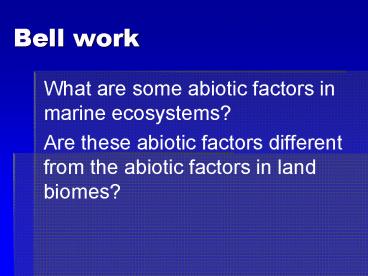Bell work - PowerPoint PPT Presentation
1 / 19
Title:
Bell work
Description:
Bell work What are some abiotic factors in marine ecosystems? Are these abiotic factors different from the abiotic factors in land biomes? Marine Ecosystems ... – PowerPoint PPT presentation
Number of Views:98
Avg rating:3.0/5.0
Title: Bell work
1
Bell work
- What are some abiotic factors in marine
ecosystems? - Are these abiotic factors different from the
abiotic factors in land biomes?
2
Marine Ecosystems
3
- Scientists call ecosystems in the ocean marine
ecosystems. - Marine ecosystems are shaped by abiotic factors.
- water temperature
- water depth
- the amount of sunlight that passes into the
water.
4
Plankton
- Plankton form the base of the ocean's food
chains. - Plankton are tiny organisms that float near the
surface of the water. - Many plankton are producers.
- They use photosynthesis to make their own food.
5
Temperature
- The temperature of ocean water decreases as the
depth of the water increases.
6
Temperature
- Temperatures in the surface zone vary with
latitude. - Areas of the ocean along the equator are warmer
than areas closer to the poles. - Surface zone temperatures also vary with the time
of year. - Temperature affects the animals that live in
marine ecosystems. - A sudden change in temperature may cause these
animals to die.
7
Depth and Sunlight
- In addition to water temperature, life in the
ocean is affected by water depth and the amount
of sunlight that passes into the water. - Pg 104-105
8
The Intertidal Zone
- The intertidal zone is the place where the ocean
meets the land. - This area is exposed to the air for part of the
day. Low Tide. - The animals that live in the intertidal zone have
adaptations to survive exposure to air and to
keep from being washed away by the waves.
9
Life in the Intertidal zone
- These areas include mudflats, sandy beaches, and
rocky shores. - The organisms that live in mudflats include worms
and crabs. - Shorebirds feed on these animals.
- Organisms that live on sandy beaches include
worms, clams, crabs, and plankton.
10
Life in the Intertidal zone
- On rocky shores, organisms have adaptations to
keep from being swept away by crashing waves. - Some organisms use rootlike structures called
holdfasts to attach themselves to the rocks. - Other organisms attach themselves to rocks by
releasing a special glue.
11
The Neritic Zone
- In the neritic zone, the water becomes deeper.
- The ocean floor starts to slope downward. The
water is warm and receives a lot of sunlight. - Many interesting plants and animals, such as
corals, sea turtles, fishes, and dolphins, live
in this zone.
12
Life in the Neritic Zone
- Most coral reefs are found in warm, shallow areas
of the neritic zone. - The reefs are made up of small animals called
corals. - Corals live in large groups.
- When corals die, they leave their skeletons
behind. - New corals grow on these remains.
13
Life in the Neritic Zone
- Over time, layers of skeletons build up and form
a reef. - This reef provides a home for many marine animals
and plants. - These organisms include algae, brightly colored
fishes, sponges, sea stars, and sea urchins.
14
The Oceanic Zone
- In the oceanic zone, the sea floor drops sharply.
- This zone contains the deep water of the open
ocean. - Plankton can be found near the water surface.
- Animals, such as fishes, whales, and sharks, are
found in the oceanic zone. - Some animals in this zone live in very deep
water.
15
The Benthic Zone
- The benthic zone is the ocean floor. The deepest
parts of the benthic zone do not get any
sunlight. - Animals, such as fishes, worms, and crabs, have
special adaptations to the deep, dark water. - Many of these organisms get food by eating
material that sinks from above.
16
Life elsewhere in the Ocean
- There are several ecosystems that boarder other
ecosystems. - Some examples are Estuaries, Sagasso Sea, and
Polar ice areas.
17
Estuaries
- An area where fresh water from streams and rivers
spills into the ocean is called an estuary. - The fresh water from rivers and the salt water
from the ocean are always mixing. - The amount of salt in the water is always
changing. Plants and animals that live in
estuaries must be able to survive the changing
concentrations of salt.
18
The Sargasso Sea
- An ecosystem called the Sargasso Sea is found in
the middle of the Atlantic Ocean. - This ecosystem contains floating rafts of algae
called sargassums. - Many of the animals that live in the Sargasso Sea
are the same color as sargassums, which helps the
animals hide from predators.
19
Polar Ice
- The Arctic Ocean and the ocean around Antarctica
make up another marine ecosystem. - These icy waters are rich in nutrients, which
support large numbers of plankton. - Many fishes, birds, and mammals rely on the
plankton for food. - Animals, such as polar bears and penguins, live
on the polar ice.































